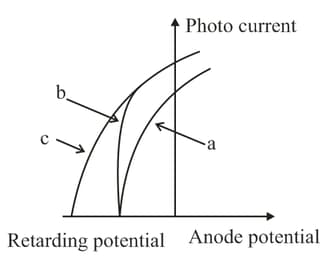Einstein's Photoelectric Equation
Einstein's Photoelectric Equation: Overview
This Topic covers sub-topics such as Work Function of a Metal, Photoelectric Current, Maximum Kinetic Energy of Photoelectrons, Einstein's Equation of Photoelectric Effect and, Stopping Potential for Photoelectrons
Important Questions on Einstein's Photoelectric Equation
The stopping potential in an experiment on photoelectric effect is 1.5 V. The maximum kinetic energy of the photoelectron emitted would be:
The stopping potential in an experiment on the photoelectric effect is . The maximum kinetic energy of the photoelectron emitted would be
The stopping potential in an experiment on the photoelectric effect is . The maximum kinetic energy of the photoelectrons emitted would be
The maximum kinetic energy of a photoelectron is 3 eV. Its stopping potential is:
The maximum kinetic energy of a photoelectron is . Its stopping potential is
The Einstein’s photoelectric equation is:
The Einstein’s photoelectric equation is:
The following graph shows the variation of stopping potential with frequency of the incident radiation for two photosensitive metals and .
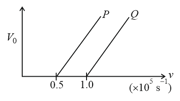
Which metal has
(i) a smaller threshold wavelength?
(ii) smaller kinetic energy?
The following graph shows the variation of stopping potential with the frequency of the incident radiation for two photosensitive metals and :
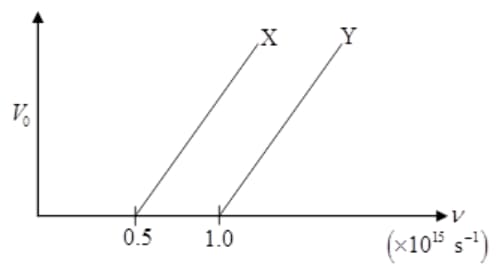
(i) Which of the metals has larger threshold wavelength? Give reason.
(ii) Explain, giving reason, which metal gives out electrons, having larger kinetic energy, for the same wavelength of the incident radiation.
The graph between frequency of incident radiations and stopping potential for a given photosensitive material is as follows.
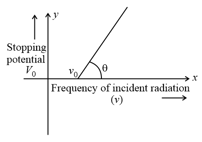
What information can be obtained from the value of the intercept on the potential axis?
The graph between frequency of incident radiations and stopping potential for a given photosensitive material is as follows.
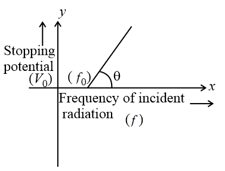
What information can be obtained from the value of the intercept on the potential axis?
Show graphically how the stopping potential for a given photosensitive surface varies with the frequency of the incident radiation.
In the photo-electron emission, the energy of the emitted electron is
The maximum kinetic energy of electrons emitted in the photoelectric effect is linearly dependent on the________________ of the incident radiation.
A photon of energy and wavelength falls on a metal surface and the ejected electrons have velocity . If the of the incident light is decreased by , the maximum velocity of the emitted electrons is doubled. The work function of the metal is
The maximum kinetic energy of photoelectrons is . When the wavelength of the light is increased by , the maximum kinetic energy decreases to . Which of the following is (are) correct?
When light of a given wavelength is incident on a metallic surface, the minimum potential needed to stop the emitted photoelectrons is . This potential drops to if another source with wavelength four times that of the first one and intensity half of the first one is used. What are the wavelength of the first source and the work function of the metal, respectively? [Take .]
In a photoelectric experiment, increasing the intensity of incident light:
In a photoelectric experiment, ultraviolet light of wavelength is used with lithium cathode having work function . If the wavelength of incident light is switched to , find out the change in the stopping potential.
The figure shows a plot of photo current versus anode potential for a photo sensitive surface for three different radiations. Which one of the following is a correct statement?
